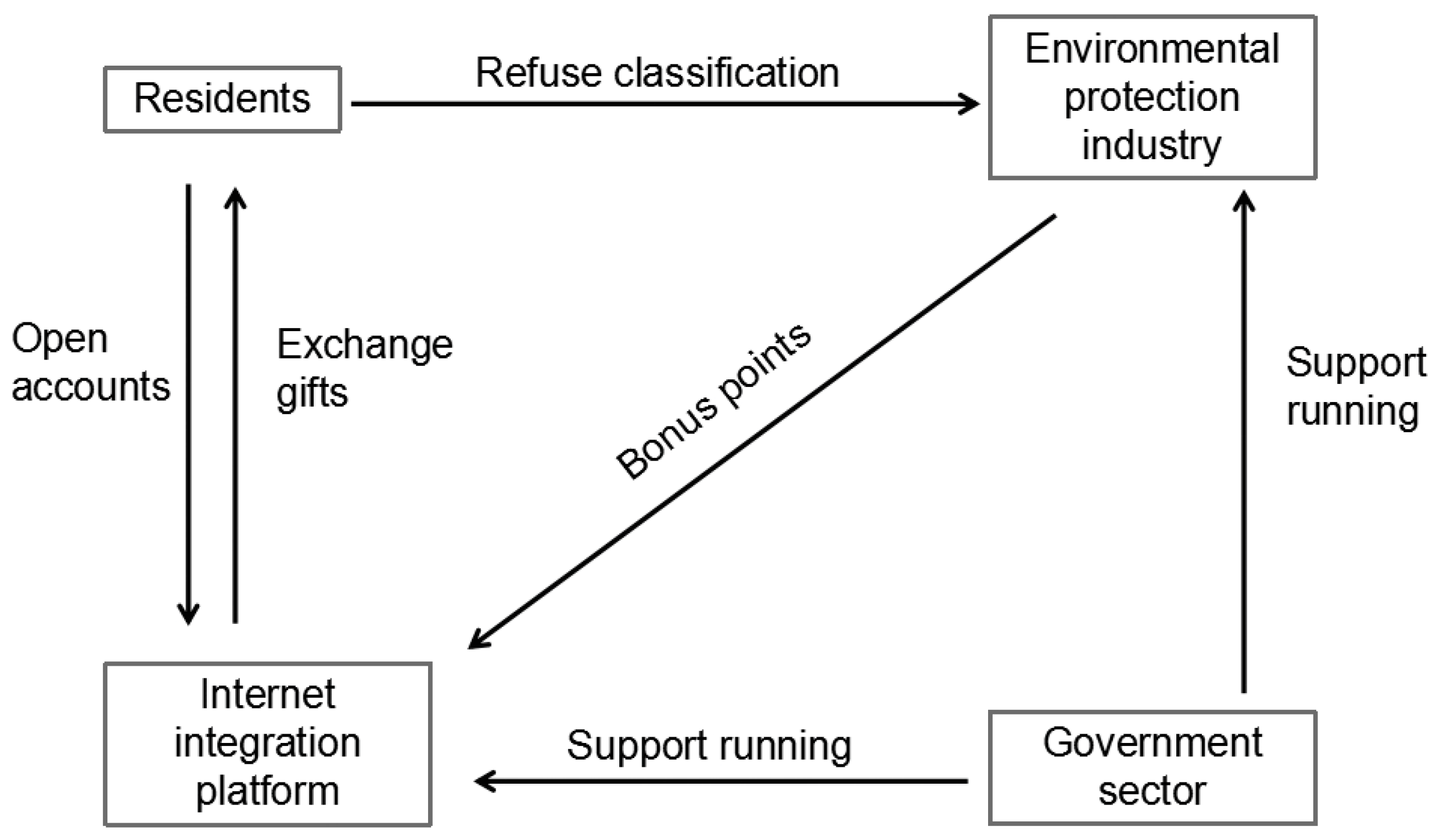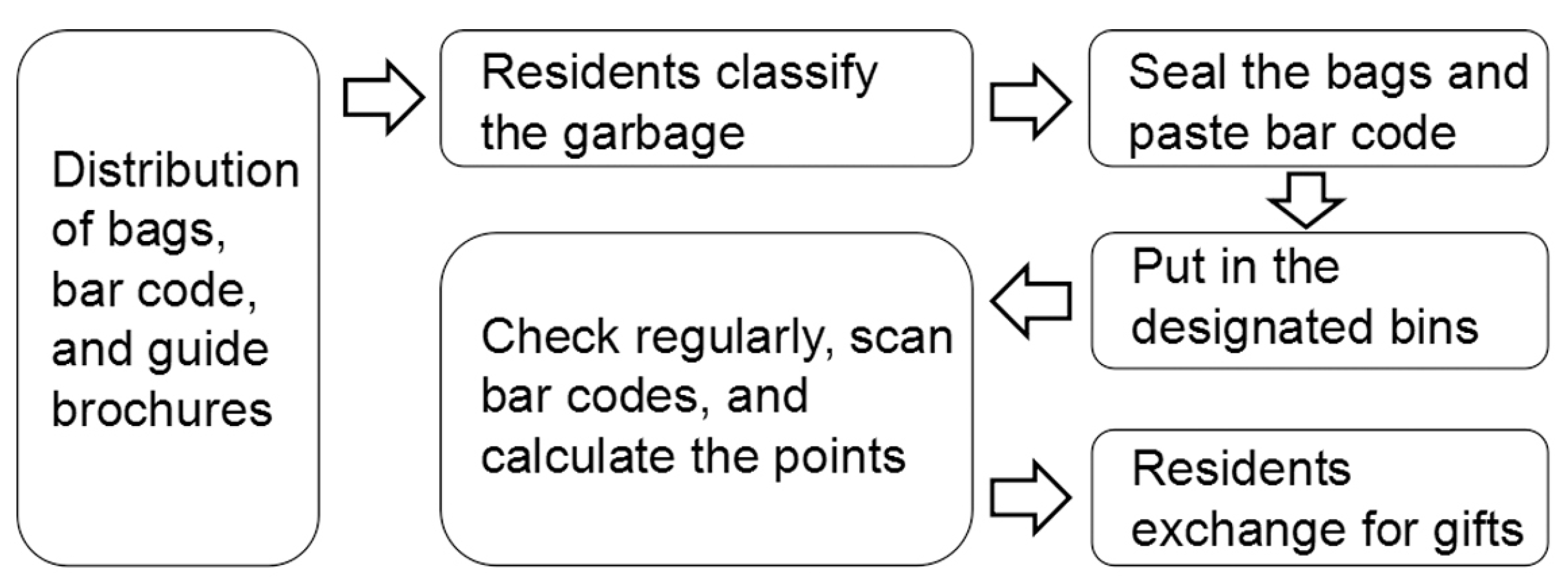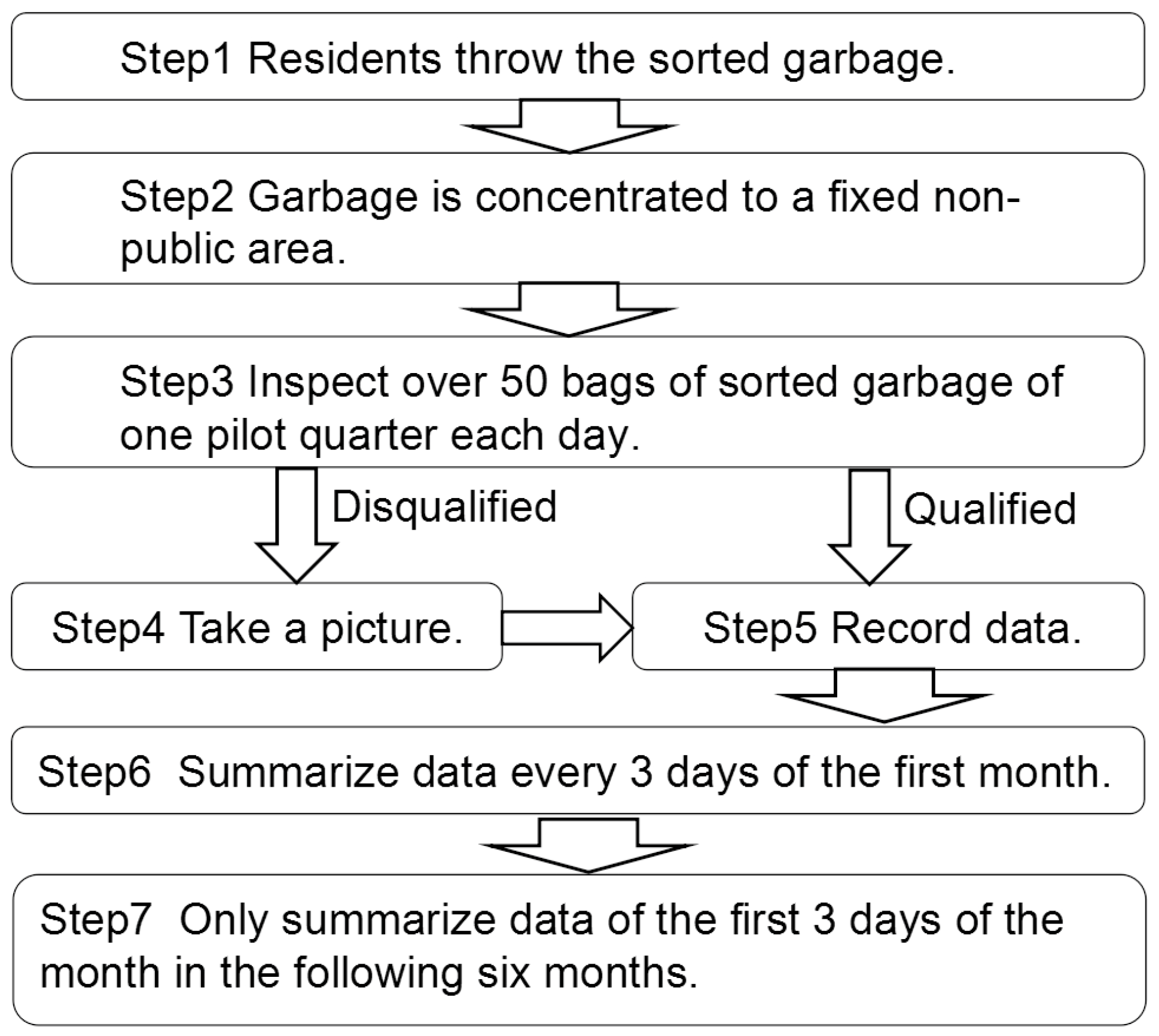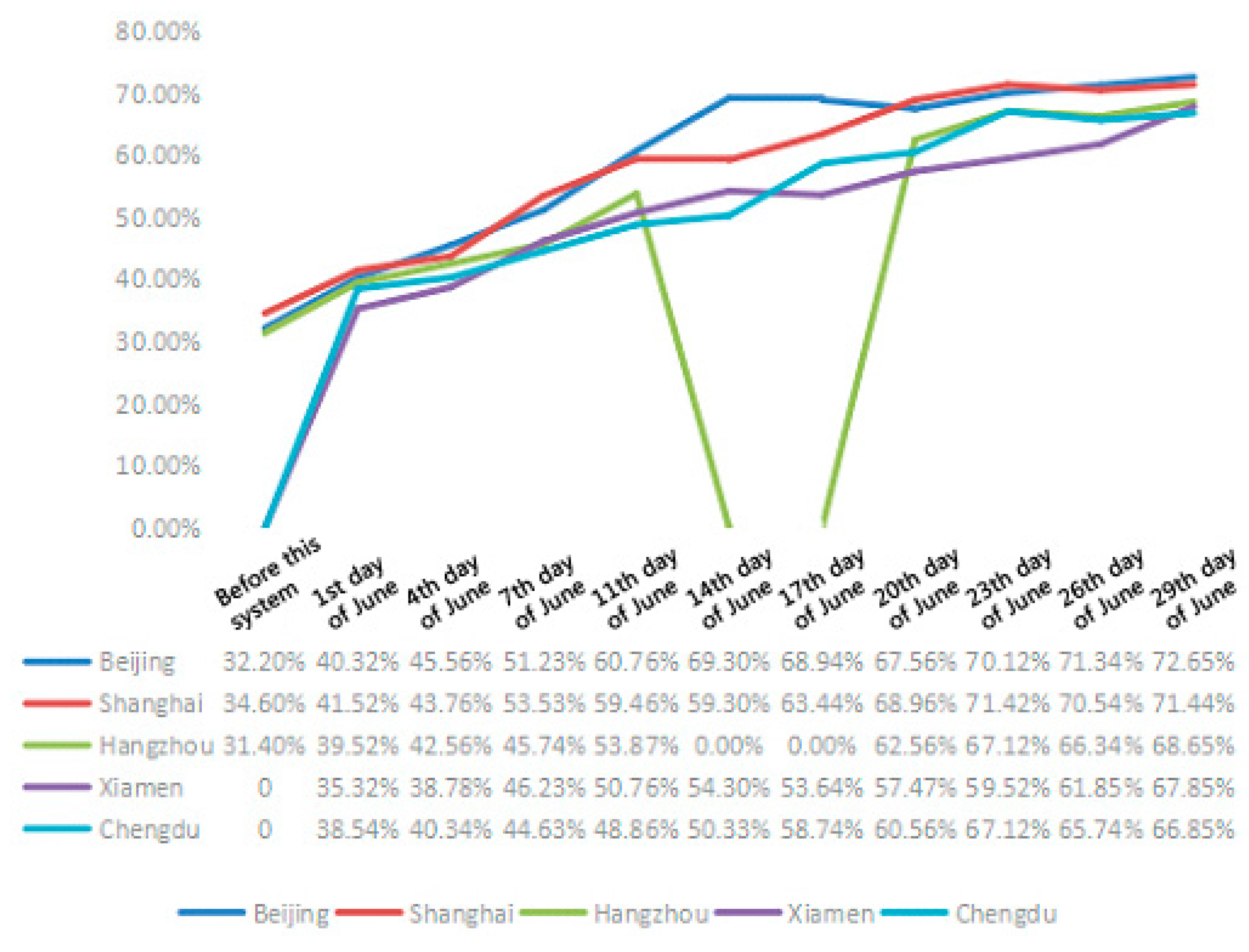Bonus Point System for Refuse Classification and Sustainable Development: A Study in China
Abstract
:1. Introduction
1.1. Cities Besieged by Waste and Its Solution
1.2. Some Measures That Promote Sorting in Different Countries
1.3. China’s Refuse Classification System
2. Materials and Methods
2.1. System Design
2.1.1. Operation and Participation
2.1.2. Operating Mechanism of Bonus Points
2.1.3. Sustainable Development of the System
2.2. Research Methods
2.2.1. Accuracy of Refuse Classification
2.2.2. Environmental Awareness
2.2.3. Residents’ and Internet Integration Platform Companies’ Cognition
3. Results
3.1. The Accuracy of Refuse Classification
3.2. Residents’ Level of Environment Awareness
3.2.1. Cognition about Environmental Situations and Environmental Awareness
3.2.2. Environmental Responsibility (Sense of Justice for Environment)
3.3. Residents’ and Internet Integration Platform Companies’ Cognition
3.3.1. Residents’ Cognition on the System
3.3.2. Internet Integration Platform Companies’ Cognition on the System
“In 2015, Shanghai set up the green account management and running unit and institution. In the same year in July, ‘Green account internet plus’ platform was officially launched. As an internet platform of the green account, it is equipped with modern scientific technology. Residents can learn refuse classification knowledge, check the points inside the green account, and give feedbacks and suggestions through channels such as official website, wechat, and APP. By the end of March 2017, after the efforts from the related departments in districts and counties and positive promotion and collaboration from social groups and the third-party companies, distribution of the single cards and set cards of green account has respectively reached 1.814332 million and 0.131730 million families. It has been in a certain scale, with the total coverage of families reached 2.415406 families and the total points of 1.27 billion points.”
“Refuse classification is not originated from Beijing. Many cities have tried to do it. Efforts as quarters using recyclable refuse to offset the property fees and environment protection industries in Hangzhou entering local quarters to recycle recyclable refuse under bonus point system are not rare. However, the problem lies in that no matter who will give the rewards of refuse classification, the challenge of sustainable development cannot be avoided. Many tries failed in a short period after launched for the cost of running. In our country, the comprehensive utilization of waste industry is still at start-up stage. Therefore, compared with the developed countries, there is a huge gap in terms of the range of waste disposal and ways of disposal. Objectively, those are all obstacles for the going of sorted garbage and constrain the joint between the comprehensive utilization of waste industry and garbage collection.”
4. Discussion
4.1. The Rationality and Validity of the Experiment
4.2. An Innovative Mode to Solve the Environmental Dilemma
4.3. Improved Environmental Knowledge
4.4. The Need of Relative Laws and Regulations for Sustainable Development
5. Conclusions
- The system constructs a new mode of garbage sorting. This is an effective method of refuse reduction, recycling, and re-utilization. Our researchers used empirical data to analyze the system. Under this system, the accuracy of residents’ garbage sorting was much higher, suggesting that the system has some practicability. The bonus point system is beneficial for increased public involvement and increased accuracy of garbage sorting.
- Genuine knowledge comes from practice. There was improved environment awareness after implementing this system, with residents more willing to take on environmental protection responsibility. During the pilot period, there were regular activities on the internet platform that promoted garbage knowledge education. Residents were involved directly in garbage sorting, which effectively increased their awareness of environmental protection. However, ongoing publicity and coordination of various policies are still required.
Acknowledgments
Author Contributions
Conflicts of Interest
References
- Yang, H.; Xia, J.; Thompson, J.R.; Flower, R.J. Urban construction and demolition waste and landfill failure in Shenzhen, China. Waste Manag. 2017, 63, 393–396. [Google Scholar] [CrossRef] [PubMed]
- Bie, R.; Song, X.; Ji, X.; Chen, P.; Liu, Q. Status and policy of domestic waste treatment at home and abroad. China Resour. Compr. Util. 2013, 9, 31–35. [Google Scholar] [CrossRef]
- Vrijheid, M. Health effects of residence near hazardous waste landfill sites: A review of epidemiologic literature. Environ. Health Perspect. 2000, 108, 101. [Google Scholar] [CrossRef] [PubMed]
- Abas, M.A.; Wee, S.T. Municipal solid waste management in Malaysia: An insight towards sustainability. Int. Conf. Hum. Habitat Environ. 2016. [Google Scholar] [CrossRef]
- Hong, J.; Chen, Y.; Wang, M.; Ye, L.; Qi, C.; Yuan, H.; Zheng, T.; Li, X. Intensification of municipal solid waste disposal in China. Renew. Sustain. Energy Rev. 2017, 69, 168–176. [Google Scholar] [CrossRef]
- Wang, X.; Jia, M.; Lin, X.; Xu, Y.; Ye, X.; Kao, C.M.; Chen, S. A comparison of CH4, N2O and CO2 emissions from three different cover types in a municipal solid waste landfill. J. Air Waste Manag. Assoc. 2017, 67, 507–515. [Google Scholar] [CrossRef] [PubMed]
- Margallo, M.; Taddei, M.B.M.; Hernández-Pellón, A.; Aldaco, R.; Irabien, A. Environmental sustainability assessment of the management of municipal solid waste incineration residues: A review of the current situation. Clean Technol. Environ. Policy 2015, 17, 1333–1353. [Google Scholar] [CrossRef]
- Zhu, B.; Wang, Y.; Wang, W.; Zhao, N. Status and development trend of urban garbage resource. Appl. Energy Technol. 2015. [Google Scholar] [CrossRef]
- Takaoka, E.; Tanaka, Y.; Nakanishi, M. Implementation and evaluation of adaptive garbage collection. Syst. Comput. Jpn. 2015, 31, 83–90. [Google Scholar] [CrossRef]
- Guerin, D.; Crete, J.; Mercier, J. A multilevel analysis of the determinants of recycling behavior in the European countries. Soc. Sci. Res. 2001, 30, 195–218. [Google Scholar] [CrossRef]
- Usui, T.; Kakamu, K.; Chikasada, M. To introduce recycling or not: A panel data analysis in Japan. Resour. Conserv. Recycl. 2015, 101, 84–95. [Google Scholar] [CrossRef]
- McDavid, J.C.; Mueller, A.E. Across-Canada analysis of the efficiency of residential recycling services. Can. Public Adm. 2008, 51. [Google Scholar] [CrossRef]
- Tan, R.B.; Khoo, H.H. Impact assessment of waste management options in Singapore. J. Air Waste Manag. Assoc. 2006, 56. [Google Scholar] [CrossRef]
- Zhang, D.; Tan, S.K.; Gersberg, R.M. A comparison of municipal solid waste management in Berlin and Singapore. Waste Manag. 2010, 30, 921. [Google Scholar] [CrossRef] [PubMed]
- Reschovsky, J.D.; Stone, S.E. Market incentives to encourage household waste recycling: Paying for what you throw away. J. Policy Anal. Manag. 1994, 13, 120–139. [Google Scholar] [CrossRef]
- Wang, J. Comparison of waste sorting in China and Germany and waste sorting method in China. Environ. Sanit. Eng. 2004. [Google Scholar] [CrossRef]
- Bom, U.B.; Belbase, S.; Bibriven, R. Public perceptions and practices of solid waste recycling in the city of laramie in Wyoming, USA. Recycling 2017, 2. [Google Scholar] [CrossRef]
- Yang, W.S.; Park, J.K.; Park, S.W.; Seo, Y.C. Past, present and future of waste management in Korea. J. Mater. Cycles Waste Manag. 2015, 17, 207–217. [Google Scholar] [CrossRef]
- Lee, D.H.; Behera, S.K.; Kim, J.W.; Park, H.S. Methane production potential of leachate generated from Korean foodwaste recycling facilities: A lab-scale study. Waste Manag. 2008, 29. [Google Scholar] [CrossRef]
- Steuer, B.; Ramusch, R.; Part, F.; Salhofer, S. Analysis of the value chain and network structure of informal waste recycling in Beijing, China. Resour. Conserv. Recycl. 2016, 117. [Google Scholar] [CrossRef]
- Fei, F.; Qu, L.; Wen, Z.; Xue, Y.; Zhang, H. How to integrate the informal recycling system into municipal solid waste management in developing countries: Based on a China’s case in Suzhou urban area. Resour. Conserv. Recycl. 2016, 110, 74–86. [Google Scholar] [CrossRef]
- Kostoff, R.N. Assessing research impact: Semiquantitative methods. Eval. Rev. 1994, 18, 11–19. [Google Scholar] [CrossRef]
- Shen, X. Environmental economics: Theoretical foundations, policy tools and prospect. Xiamen Univ. (Philos. Soc. Sci. Ed.) 2008, 4, 19–26. [Google Scholar] [CrossRef]
- Wolters, M.L.; Sun, Z.; Huang, C.; Kuenzer, C. Environmental awareness and vulnerability in the Yellow River Delta: Results based on a comprehensive household survey. Ocean Coast. Manag. 2016, 120, 1–10. [Google Scholar] [CrossRef]
- Sáez-Martínez, F.J.; Díaz-García, C.; González-Moreno, Á. Factors promoting environmental responsibility in European SMEs: The effect on performance. Sustainability 2016, 8. [Google Scholar] [CrossRef]
- He, P.; Zhuang, Y.; Lin, Y.; Zheng, C. Environmental law clinics in collaboration with environmental NGOs in China. Sustainability 2017, 9, 337. [Google Scholar] [CrossRef]
- Liobikien, G.; Juknys, R. The role of values, environmental risk perception, awareness of consequences, and willingness to assume responsibility for environmentally-friendly behaviour: The Lithuanian case. J. Clean. Prod. 2016, 112, 3413–3422. [Google Scholar] [CrossRef]
- Nie, W. Environment cognition, environmental responsibility and public mitigation action. Sci. Technol. Manag. Res. 2016, 15, 252–256. [Google Scholar] [CrossRef]
- Fellowship, M. Expectancy-value theory of achievement motivation. Contemp. Educ. Psychol. 2017, 25, 68–81. [Google Scholar] [CrossRef]





| Class | Type | Name | Unit | Bonus Points |
|---|---|---|---|---|
| Solid wastes | Colored glass | Beer bottle | kilogram (kg.) | 25 |
| Wine bottle | kilogram (kg.) | |||
| Colored glassware | kilogram (kg.) | |||
| Colorless glass | Glass bottle, etc. | kilogram (kg.) | ||
| Armored glass | Auto glass, etc. | kilogram (kg.) | ||
| Hazardous wastes (mercury-containing lighting products) | All types of tube | Energy saving lamps, fluorescent tubes, incandescent bulbs, etc. | kilogram (kg.) | 10 |
| Hazardous wastes (Battery) | Rechargeable battery | Nickel hydrogen, nickel chromium, lithium ion | kilogram (kg.) | 1650 |
| Common dry cell | Alkaline and other not rechargeable | kilogram (kg.) | ||
| Hazardous wastes (E-waste) | Computer | Mouse, keyboard, camera, video card, network card, mainboard, etc. | piece | 1350 |
| Communication devices | Telephone, mobile phone | piece | 1350 | |
| Other digital products | MP3, MP4, induction cooker, rice cooker, radio, etc. | piece | 1350 | |
| Solid waste (plastics, metal products) | Plastic bottle | Coke bottle, mineral water bottle | piece | 10 |
| Other plastic products | kilogram (kg.) | 300 | ||
| cans | Aluminum cans, iron cans | piece | 15 | |
| Other metal products | kilogram (kg.) | 270 | ||
| Kitchen waste | Leftovers, Leaves Roots and rotten fruit peel, rotten leaves, etc. | kilogram (kg.) | 10 | |
| Solid waste (paper, cloth) | Paper products, clothing products | kilogram (kg.) | 80 |
| Questions | Number of Items |
|---|---|
| Refuse classification knowledge | 10 points/item × 10 |
| Cognition on environment situation | 10 points/item × 5 |
| Environment knowledge | 10 points/item × 5 |
| Questions | Rating Standards | |
|---|---|---|
| Environment protection awareness (scores accumulated) | 1. It is hard for people like me to do something for the environment. 2. There are more important things to do than environmental protection in life. 3. Unless everyone makes an effort, my environment protection efforts will be pointless. | Strongly disagree = 5 |
| Disagree = 4 | ||
| Don’t care = 3 | ||
| Agree = 2 | ||
| Fully agree = 1 | ||
| 1. Even if it will take more money and time, I will do things that are beneficial to the environment. | Strongly disagree = 1 | |
| Disagree = 2 | ||
| Don’t care = 3 | ||
| Agree = 4 | ||
| Fully agree = 5 | ||
| Willingness to contribute to the environment | To protect the environment, to what extent would you be willing to lower your living standard. | Extremely willing = 5 |
| Willing = 4 | ||
| Just so so = 3 | ||
| Unwilling = 2 | ||
| Strongly unwilling = 1 | ||
| Research Question | Data Sources | Methods of Analysis |
|---|---|---|
| The accuracy of refuse classification | Field observation | Comparative analysis |
| Residents’ environment awareness | Group questionnaire survey | Comparative analysis |
| Residents’ and internet integration platform companies’ cognition on this system | Interview | Content analysis |
| Questions | Group 1 (Points) | Group 2 (Points) | Conclusion |
|---|---|---|---|
| Refuse classification knowledge | 51 | 22 | >29 |
| Cognition on environment situation | 34 | 22 | >12 |
| Environment knowledge | 27 | 22 | >5 |
| Questions | Group 1 (Mean Value) | Group 2 (Mean Values) | Conclusion |
|---|---|---|---|
| Environment protection awareness (scores accumulated) | 12.18 | 9.72 | >2.46 |
| Willingness to contribute to the environment | 3.81 | 3.51 | >0.3 |
© 2017 by the authors. Licensee MDPI, Basel, Switzerland. This article is an open access article distributed under the terms and conditions of the Creative Commons Attribution (CC BY) license (http://creativecommons.org/licenses/by/4.0/).
Share and Cite
Guo, S.; Ding, G.; Zhao, Q.; Jiang, M. Bonus Point System for Refuse Classification and Sustainable Development: A Study in China. Sustainability 2017, 9, 1776. https://doi.org/10.3390/su9101776
Guo S, Ding G, Zhao Q, Jiang M. Bonus Point System for Refuse Classification and Sustainable Development: A Study in China. Sustainability. 2017; 9(10):1776. https://doi.org/10.3390/su9101776
Chicago/Turabian StyleGuo, Shijie, Guomin Ding, Qian Zhao, and Meini Jiang. 2017. "Bonus Point System for Refuse Classification and Sustainable Development: A Study in China" Sustainability 9, no. 10: 1776. https://doi.org/10.3390/su9101776




